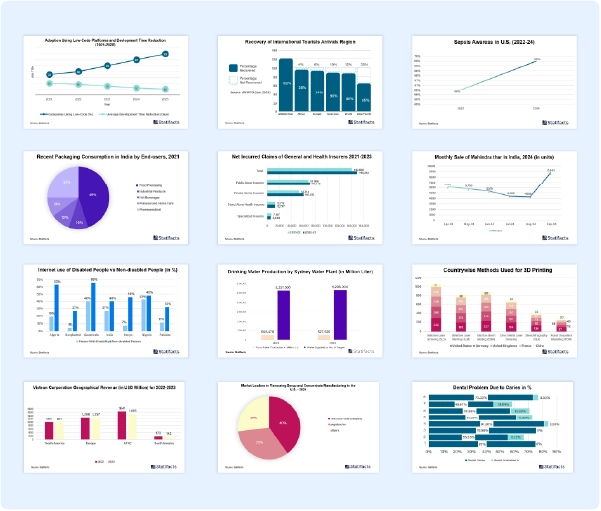The U.S. skin cancer diagnostics market size was estimated at USD 5,119 million in 2024 and is expected to be worth around USD 8,499 million by 2034, growing at a compound annual growth rate (CAGR) of 5.2% over the forecast period 2025 to 2034.
U.S. Skin Cancer Diagnostics Market Report Highlights
- By cancer type, the non-melanoma segment dominated the U.S. skin cancer diagnostics market 2024.
- By cancer type, the melanoma cancer type segment is expected to grow significantly during the forecast period.
- By test type, the skin biopsy test type segment led the U.S. skin cancer diagnostics market with the highest market share in 2024.
- By test type, the imaging test type segment is expected to grow fastest during the forecast period.
- By end-use, the hospitals and clinics end-use segment dominated the U.S. skin cancer diagnostics market with the highest market share in 2024.
- By end-use, the laboratories end-use segment is expected to grow the fastest during the forecast period.
The U.S. skin cancer diagnostics market refers to the production, distribution, and application of skin cancer diagnostics. Getting a definitive diagnosis usually involves taking a small sample of skin and conducting a skin biopsy of a target lesion analyzed by a skin pathologist. Skin cancer is a disease in which cells in the skin grow out of control. Many cases of skin cancer are caused by overexposure to ultraviolet rays from the sun, tanning beds, or sun lamps. Early detection has many benefits over the treatment of late-stage cancer.
Early detection reduces disfigurement by reducing the size and extent of surgical removal and reduces side effects that late-stage patients experience from systematic therapies. Early detection and treatment greatly affect prognosis. Regular visits with board-certified dermatologists and monthly skin self-exams can detect cancer early when treatment may be more effective. Delivery of high-quality treatment depends on accurate and timely diagnosis. In cancer care, diagnostic tests are critical for developing treatment plans and also for informing prognosis, prediction, and assessment of treatment response, disease progression, and recurrence.
Rising incidences of skin cancer, mainly in the tropical regions, are driving the growth of the U.S. skin cancer diagnostics market. The most common reasons for increasing skin cancer incidences include xeroderma pigmentosum, skin color, previous skin cancer, other risks, arsenic, sunburn, other possible causes, light-colored skin, eyes, and hair, sun exposure, moles, indoor tanning, weakened immune system, family history of melanoma, and ultraviolet radiation. Through skin analysis, it ensures that facial treatments are tailored to each individual’s unique skin type and condition, maximizing the efficiency of treatments and procedures.
It minimizes many potential risks, providing a sense of security and confidence in your skincare routine. Early detection has many benefits over the treatment of late-stage cancer. Early detection reduces disfigurement by reducing side effects, size, and extent of surgical removal. technological advancements like teledermatology are driving the growth of the U.S. skin cancer diagnostics market. Multi-cancer early detection technologies aim to provide a new approach to complement traditional cancer screening programs.
These tests detect genetic signals within blood samples using next-generation sequencing and computational algorithms to gauge the presence of different cancers. Techniques such as dermoscopy are commonly used for the non-invasive diagnosis of skin cancer. There are also several imaging tests used to diagnose skin cancers, including X-ray, ultrasound, magnetic resonance imaging (MRI), bone scan, positron emission tomography (PET) scan, and computerized tomography (CT). Technological innovation benefits include greater access to information, cost efficiency, improved profitability, reduced time, reduced costs, and faster decision-making, which helps the growth of the market.
Artificial intelligence-based systems assist in the expedited detection of skin cancer, contributing to lower morbidity and, thus, lower mortality rates. AI-based diagnosis promises many benefits. AI integration improves access to specialist-level expertise. Machine learning models recognize patterns that represent cell and tissue types and the way those components interact better, enabling pathologists to assess cancer risk. AI applications can improve skin cancer screening in the primary care setting and streamline referrals to dermatologists.
Automated detection systems based on AI reduce the complications in traditional methods and can enhance the skin cancer diagnosis rate. AI has been revolutionary in the healthcare industry, also contributing to the faster diagnosis of various types of cancer. AI algorithms have been trained on large datasets to classify clinical or dermoscopic images and can now identify skin cancers with remarkable accuracy. These factors help the growth of the U.S. skin cancer diagnostics market. AI technologies have great potential to help detect and diagnose skin cancer and to reduce the workload of overstretched healthcare.

